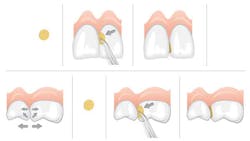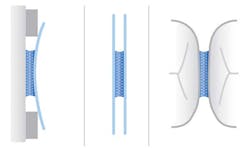Phocal: easy interproximal therapy
Each Phocal Apf disk contains 0.103 mg of sodium fluoride and 0.009 mg of hydrogen fluoride in a matrix of FD&C red 3, gum arabic, gelatin (of marine origin), propolis wax, phosphoric acid, sodium benzoate and water. These disks induce an optimized low pH environment that cleans and etches tooth surfaces and facilitates fluoride penetration and stimulates remineralization.
Each Phocal pHn disk contains 0.122 mg of sodium fluoride in a matrix of gum arabic, gelatin (of marine origin), propolis wax, sodium benzoate and water. These disks are less acidic than the Phocal Apf disks and will not etch ceramic crowns or tooth-colored restorations while inducing fluoridation and remineralization.
There are warnings for the product, including (but not limited to) the following: in rare cases, sensitivity or adverse reactions may be experienced. In such cases immediately remove the disks while preventing swallowing and refer the patient to a physician; patients less than 12 years old and patients with special needs should remain under professional supervision until the Phocal disks have biodegraded or have been removed; the disks are not intended for systemic ingestion and should be kept out of children’s reach; if more than 20 disks are accidently swallowed, seek immediate medical assistance; Phocal should not be applied in sites with: gingival inflammation, immediately prior to or after oral soft tissue surgery and in cases of known allergies to any of the Phocal ingredients.(3) Phocal disks have been developed for use only by licensed professionals in the dental care setting.
An in vitro interproximal enamel fluoride uptake study was done on these fluoride delivery vehicles.(4) The conclusion of the study, which simulated interproximal sites, showed that the disks used with or without NaF varnish significantly enhanced enamel fluoride uptake. The clinical implications are that these disks, when used alone or with NaF varnish, have the potential to effectively deliver fluoride to interproximal carious lesions.(4)
For additional information, call the company or visit the website.(5,6)
References
1. http://www.phocaltherapy.com/.
2. http://www.phocaltherapy.com/wp-content/uploads/2013/01/COLL-004_Quick_Reference_Guide_Final_Word_Version_REV.pdf.
3. http://www.phocaltherapy.com/wp-content/uploads/2013/01/COLL-004_Phocal_IFU_Final_Word_Version_REV2.pdf.
4. Jodaikin A, Cooley WE, Lippert F, and Martinez-Mier EA. In Vitro Interproximal Enamel Fluoride Uptake as a Function of Fluoride Delivery Vehicles. Compendium Supplement – Colldent, May 2013, Volume 34, Issue 4. http://www.dentalaegis.com/special-issues/2013/05/in-vitro-interproximal-enamel-fluoride-uptake-as-a-function-of-fluoride-delivery-vehicles#sthash.x6ygaO12.dpuf.
5. 888-PHOCAL-3 (746-2253).
6. www.phocaltherapy.com.




